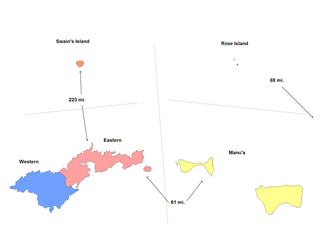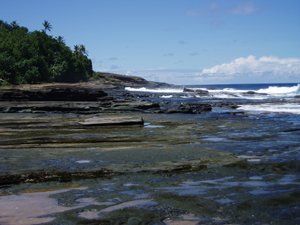Related Research Articles

This is a list of the buildings, sites, districts, and objects listed on the National Register of Historic Places in American Samoa. There are currently 31 listed sites spread across the three districts of American Samoa. There are no sites listed on the unorganized atoll of Swains Island.

The National Marine Sanctuary of American Samoa is a national marine sanctuary in American Samoa. It is the smallest, yet one of the most important, marine sanctuaries as it is home to more fish and marine mammals than any other marine sanctuary. It also provides a natural food source for sharks and other predators of the ocean.

Millstone Bluff is a natural bluff in Pope County, Illinois, United States, located near the community of Glendale. Listed on the National Register of Historic Places because of its archaeological significance, Millstone Bluff is one of three National Register sites in Pope County, along with the Golconda Historic District and part of the Kincaid Mounds State Historic Site.

Leone is a village on the south-west coast of Tutuila Island, American Samoa. Leone was the ancient capital of Tutuila Island. Leone was also where the Samoan Islands’ first missionary, John Williams, visited on October 18, 1832. A monument in honor of Williams has been erected in front of Zion Church. Its large church was the first to be built in American Samoa. It has three towers, a carved ceiling and stained glass. Until steamships were invented, Leone was the preferred anchorage of sailing ships which did not risk entering Pago Pago Harbor. Much early contact between Samoans and Europeans took place in Leone.

The Greenwich Cove Site is a prehistoric archaeological site in Warwick, Rhode Island. The site is a significant multi-component site, with finds dating from the Late Archaic to the Middle Woodland Period. It notably includes a shell midden that has only been moderately affected by vandalism and development; these are particularly rare in coastal Rhode Island. The site was added to the National Register of Historic Places in 1980.

Futiga is a village in the southwest of Tutuila Island, American Samoa. It is located inland, seven miles southwest of Pago Pago, between the villages of 'Ili'ili and Leone. It is in Tualatai County.
The Dugi Archeological Site is a prehistoric latte stone site on the north side of Rota Island in the Northern Mariana Islands. The site is a rare inland site that survived the intensive sugar cane development introduced by the Japanese during the South Seas Mandate period of the 1920s and 1930s. It consists of sixteen deteriorated latte stone structures on three high terraces. Some of the latte stones have fallen over and others are missing features normally found at these sites.

The Laulau Kattan Latte Site is a prehistoric archaeological site on the island of Saipan in the Northern Mariana Islands. Located near the shore of Laulau Bay, it is a small village site containing the remains of four latte stone house foundations, and an extensive scattering of pottery artifacts. When first reported by the pioneering archaeologist Alexander Spoehr in the 1940s, the latte stones were described as mostly fallen over and extremely weathered.

Mochong is a major prehistoric archaeological site on the island of Rota in the Northern Mariana Islands. It is considered the best preserved and largest latte village in the Marianas. ' It is an extensive village site on the northern side of the island with 47 latte stone house sites, including an extremely rare structure with 14 columns. It also has a latte stone wall, consisting of six columns and five slabs, that is more than 50 feet (15 m) long. The site has been radiocarbon dated to c. 1000 BCE. The site was first sketched in the early 19th century by the French explorer Louis de Freycinet, and was in remarkably intact condition in the 1980s.
The A'a Village Site, designated "AS-34-33" by archaeologists, is an abandoned village site on the island of Tutuila in American Samoa. Located on a bay on the northwest coast of the island, the site was first surveyed by professional archaeologists in 1985. The site has four distinct areas, in which features interpreted as house foundations have been located, as have rock walls, grave sites, and platform mounds. The site was not known to be occupied within the living memory of nearby residents, and the size of trees in the site suggests it has been abandoned since the 1860s.
The Lau'agae Ridge Quarry is a prehistoric stone quarry on the eastern side of the island of Tutuila in the United States territory of American Samoa. It is located on a ridge above another archaeological site, the prehistoric village of Tulauta. The site includes a carpet of stone flakes, evidence of rough stonework, signs of habitation, and two tia'ave, oval stone platforms found in abundance on the island.
The Maloata Village Site is a prehistoric village site on the northwestern coast of the island of Tutuila in the United States territory of American Samoa. The archaeologically sensitive site includes a variety of stone features, principally stone fences and retaining walls, with evidence from excavation of human habitation. Radiocarbon dating from one of its test pits yielded a date range of CE 550–1000, identifying the site as one of the oldest known on the island. According to oral tradition, the Maloata area was reserved for use by relatively high-status chieftains.
The Faga Village Site is a major archaeological site in the United States territory of American Samoa. Located on the north shore of the island of Ta'u, it is, according to local oral history, one of the oldest settlements in all of the Samoan islands, and an important site in the formation of Samoan culture. The site includes a large number of house foundations, terraces, stone walls, and other stone-built features. Excavations at the site have yielded radiocarbon dates indicating the site was occupied as far back as 1000 CE. The site continues to be of cultural importance to the local Samoan population.
Site As-31-72 is a prehistoric archaeological site on the island of Tutuila in the United States territory of American Samoa. Located on the Tafuna Plain, an inland area on the western half of the island, its principal feature is a long stone wall, 300 metres (980 ft) long with a maximum height of 5.4 metres (18 ft). Set on sloping ground, the top of the wall is roughly level, and is only 2.8 metres (9.2 ft) high at the upper end of the slope. Platforms and other features have been identified during archaeological examination of the structure and its surroundings in the 1990s. Its purpose is unknown; the researchers conjecture it was built because of warfare.
The Nomna Bay Site is a prehistoric archaeological site on the east coast of the United States territory of Guam. Located on the southeast coast in the community of Inarajan, the site's primary features are fourteen latte stone house sites, located within 400 feet (120 m) of the waterline of Nomna Bay. One of these house sites has a T-shaped layout, which is extremely unusual for Micronesia latte sites. In the surrounding area are fire pits and stone mortar sites. Radiocarbon dating places use of the site to between about 1360 and 1675.
The Tulauta Village Site is a prehistoric village site in far eastern Tutuila, the largest island of American Samoa. The site includes 10-13 house sites, a number of grave site, and other features, including stone enclosures interpreted as pig sties, fire pits, and walls. An upright basalt slab was found, which may have been of local religious significance. Early archaeological testing took place here in the 1970s, with more extensive examinations in the 1980s and 1990s. A large number of basalt stone flakes led an early researcher to speculate that it was a quarry site; it is more likely the inhabitants were working stone quarried from a site on the ridge above.

Old Vatia is a prehistoric village site on the north side of Tutuila, the largest island of American Samoa. The site is located on the Faiga ridge, above the modern village of Vatia in the National Park of American Samoa. It is stretched linearly along the ridge, with terraced areas that have features such as stone house foundations and pavement. The site, believed to have been occupied c. 1300–1750, is one of the island's few upland village sites. It was first identified in the 1960s and recorded in detail in 1989.
The Tataga-Matau Fortified Quarry Complex, designated Site AS-34-10, is a major archaeological complex on Tutuila, the largest island of American Samoa. Located in an upland area on the western side of the island above the village of Leone, the complex consists of a series of basalt quarries and structures that archaeologists have interpreted as having a military defensive purpose. The site has been known since at least 1927, and was first formally surveyed in the 1960s. Features of the site include extraction pits, from which basalt was quarried for the manufacture of stone tools and weapons, as well as domestic features such as grinding stones. Archaeologists in 1985 noted that some of the sites features were, including trenches and terracing, were made in areas that were unsuitable for the production of stone tools, and closely resemble known military defensive structures in other areas of the Samoan islands. The site extends along a network of ridges for more than 1.4 kilometres (0.87 mi). Radiocarbon dating of elements of site indicate periods of occupation and/or use from c. 200 CE to the period of European contact.
The Great Diamond Island Site, designated Site 9-16 by the Maine Archaeological Survey, is a prehistoric archaeological site on Great Diamond Island in Casco Bay, off the coast of southern Maine. Principally a shell midden, the site is an important window into the habitation and usage history of the Casco Bay region by Native Americans. The site was listed on the National Register of Historic Places in 1979.

Taputimu is a village in southwestern Tutuila Island in American Samoa. It is the nearest village to the Fagatele Bay National Marine Sanctuary, although the main access is from the neighboring village of Futiga. It is home to Leala Shoreline National Natural Landmark and Leala Sliding Rock. Leala Sliding Rock is a natural rock formation between Vailoatai and Taputimu, which is a scenic landmark as well as a natural playground or slide. It was created by the ebb and flow of the ocean; the erosion has created a smooth shoreline site. It is located in Tualatai County in the Western District of Tutuila.
References
- 1 2 "National Register Information System". National Register of Historic Places . National Park Service. July 9, 2010.
- ↑ "Final Project Reports for Tulauta and Fagatele Bay Prehistoric Villages and Leone Bay Petroglyphs, December 1985" (PDF). University of Hawaii. Retrieved 2015-05-21.